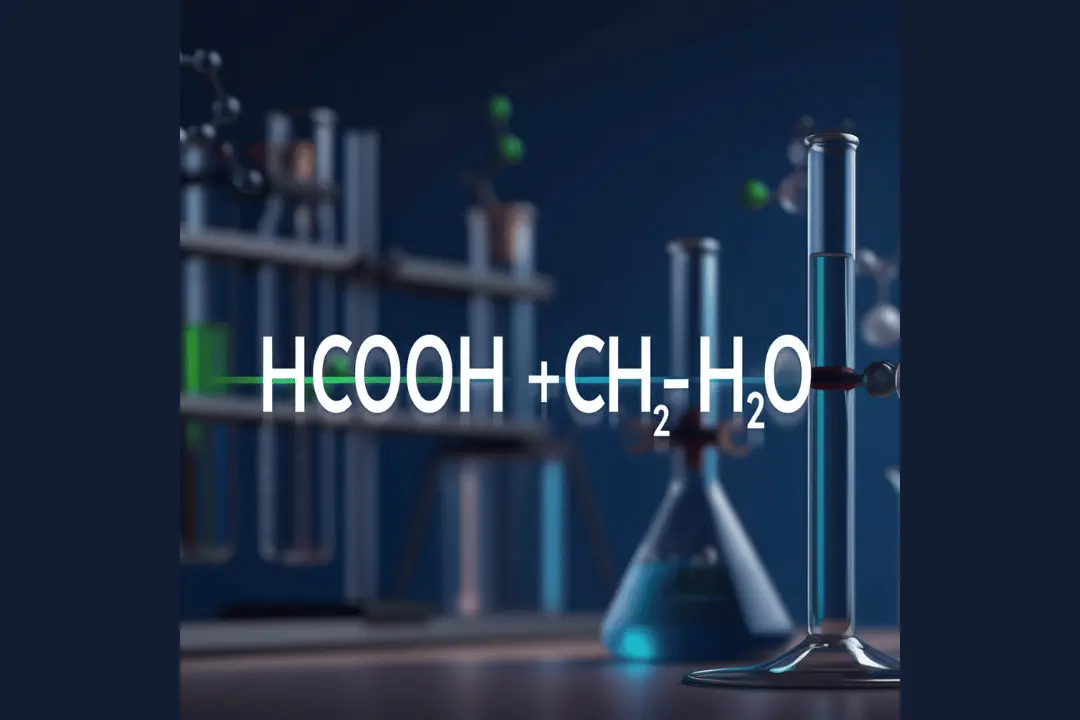The world of chemistry is filled with fascinating reactions that form the building blocks of our universe. One such interaction is the reaction between formic acid (HCOOH) and a methylene group (CH2) to produce water (H2O). While it may seem like a simple equation on paper, this process holds significant importance in organic chemistry and has several practical applications.
This article will guide you through everything you need to know about the HCOOH + CH2 → H2O reaction. We will explore the chemical components, break down the reaction mechanism, discuss its real-world applications, and clear up common misconceptions. Whether you are a student, a researcher, or simply curious about chemistry, this guide will provide a clear and comprehensive explanation.
What is the Reaction HCOOH + CH2 → H2O?
At its core, this chemical equation represents the interaction between an acid and a reactive intermediate. To understand the reaction, we must first look at the individual components:
- HCOOH (Formic Acid): This is the simplest carboxylic acid. It’s a colorless liquid with a pungent smell, naturally found in the venom of ants and bees. Its structure consists of a hydrogen atom attached to a carboxyl group (-COOH).
- CH2 (Methylene): This is a highly reactive organic molecule known as a carbene. It contains a neutral carbon atom with a valence of two and two unshared valence electrons. The methylene group is an intermediate, meaning it’s a short-lived species that appears during a reaction pathway.
- H2O (Water): The familiar and essential compound made of two hydrogen atoms bonded to one oxygen atom.
When these components interact under the right conditions, a chemical transformation occurs. The formic acid molecule donates a proton (H+), which combines with the methylene group, leading to a series of steps that ultimately form water and other products. This reaction is a great example of acid-base chemistry and the behavior of reactive intermediates in organic synthesis.
Reaction Mechanism of HCOOH + CH2 → H2O
Understanding the reaction mechanism provides a step-by-step view of how reactants are transformed into products. The interaction between formic acid and methylene is not a single-step process. It involves the movement of electrons and atoms as the molecules collide and rearrange.
Let’s break down the probable pathway for this reaction:
- Protonation of Methylene: Formic acid is an acid, which means it can donate a proton (H+). Methylene (CH2) is a strong base. The first step involves the acidic proton from the carboxyl group of formic acid being transferred to the methylene group. This forms the formate ion (HCOO-) and the methyl cation (CH3+).
- Nucleophilic Attack: The formate ion (HCOO-) is a nucleophile, meaning it is attracted to positively charged centers. The methyl cation (CH3+) is an electrophile. However, in this specific context, the direct reaction pathway to form water is more complex. A more likely scenario in a broader chemical environment involves the methylene group inserting itself into one of the bonds of the formic acid molecule.
- Insertion Reaction: Carbenes like methylene are well-known for their ability to perform insertion reactions. The CH2 group can insert into the O-H bond of the formic acid. This would form methyl formate (HCOOCH3). This reaction itself doesn’t produce water directly.
- Dehydration Context: The equation HCOOH + CH2 → H2O is somewhat simplified. It likely represents a part of a larger reaction sequence or describes a theoretical process where the elements rearrange to form water. For instance, if methylene were to react with two molecules of formic acid, it could facilitate a dehydration reaction, leading to the formation of an anhydride and water.
The most direct interpretation is that the elements involved (2 carbons, 2 hydrogens from CH2, 2 hydrogens from HCOOH, and 2 oxygens) rearrange. However, a step-by-step mechanism in a typical lab setting would likely proceed through stable intermediates rather than a direct formation of H2O from just one molecule of each reactant.
Applications of the Reaction
While the direct reaction between formic acid and methylene may be specific, the principles behind it are fundamental to many industrial and synthetic processes. Formic acid reactions and the behavior of carbene intermediates are crucial in various fields.
- Organic Synthesis: Formic acid is a valuable reagent in organic chemistry. It serves as a source of hydride ions and is used as a reducing agent in processes like the Eschweiler-Clarke reaction to methylate amines.
- Industrial Processes: Formic acid is used as a preservative and antibacterial agent in livestock feed. It is also employed in leather and textile production and as a coagulant in rubber manufacturing.
- Carbene Chemistry: Methylene and other carbenes are powerful tools for creating new carbon-carbon bonds. They are used in cyclopropanation reactions, where a three-membered ring is added to a molecule, a common structure in pharmaceuticals and natural products.
Understanding how an acid like HCOOH interacts with a reactive intermediate like CH2 helps chemists design new synthetic routes to create complex molecules more efficiently.
Importance of HCOOH + CH2 → H2O in Chemistry
This reaction, and others like it, are significant for several reasons. They provide a practical window into fundamental chemical principles that govern how molecules behave and interact.
First, it highlights the concepts of acid-base chemistry. The transfer of a proton from formic acid is a classic example of Brønsted-Lowry acid-base theory.
Second, it introduces the role of reactive intermediates. Methylene is not a stable, bottled chemical. It is generated in-situ (within the reaction mixture) and reacts immediately. Studying these intermediates is key to understanding complex reaction mechanisms and controlling chemical outcomes.
Finally, it demonstrates the power of bond formation and rearrangement. Chemistry is all about breaking and making bonds. This reaction shows how simple starting materials can be transformed into essential products like water and other organic molecules through a precise sequence of events.
Common Misconceptions About the Reaction
The simplified nature of the equation HCOOH + CH2 → H2O can lead to some misunderstandings. It’s important to clarify these points with scientific accuracy.
- Misconception 1: It’s a simple, one-step reaction. As discussed in the mechanism section, this is not a straightforward mixing of two stable chemicals. It involves unstable intermediates and likely multiple steps. The equation is a summary of the overall transformation of elements rather than a literal depiction of the molecular process.
- Misconception 2: Methylene is a common, stable reactant. Methylene is highly reactive and must be generated during the reaction. It cannot be stored in a bottle. This is a crucial detail for anyone trying to understand or replicate reactions involving carbenes.
- Misconception 3: Water is the only product. The reaction must conserve mass. The starting materials contain carbon and oxygen atoms that are not accounted for in the H2O product. Depending on the exact pathway, other products like formaldehyde (CH2O) or methyl formate (HCOOCH3) would also be formed.
FAQs About HCOOH + CH2 → H2O
What are the main products of the HCOOH + CH2 reaction?
Besides water (H2O), the reaction would need to produce other molecules to account for all the atoms. Based on the reactants, possible products include methyl formate (HCOOCH3) or formaldehyde (CH2O), depending on the reaction pathway.
Is this reaction exothermic or endothermic?
Reactions involving highly reactive intermediates like methylene are typically very exothermic. This means they release a significant amount of energy, usually in the form of heat, as stable bonds are formed.
What conditions are required for this reaction?
Generating methylene (CH2) requires specific conditions, often involving photolysis (using light to break down a precursor like diazomethane, CH2N2) or thermolysis (using heat). The reaction would need to be conducted in a controlled environment, often at low temperatures, to manage the high reactivity of the methylene carbene.
Conclusion
The reaction HCOOH + CH2 → H2O serves as an excellent case study in the principles of organic chemistry. It connects the dots between acid-base theory, the behavior of reactive intermediates, and the fundamental processes of bond formation. While the equation itself is a simplification, the chemical concepts it represents are at the heart of how chemists build molecules and drive industrial processes.
By breaking down the components, exploring the mechanism, and understanding its broader significance, we gain a deeper appreciation for the elegant and complex dance of atoms and molecules that defines the chemical world.

